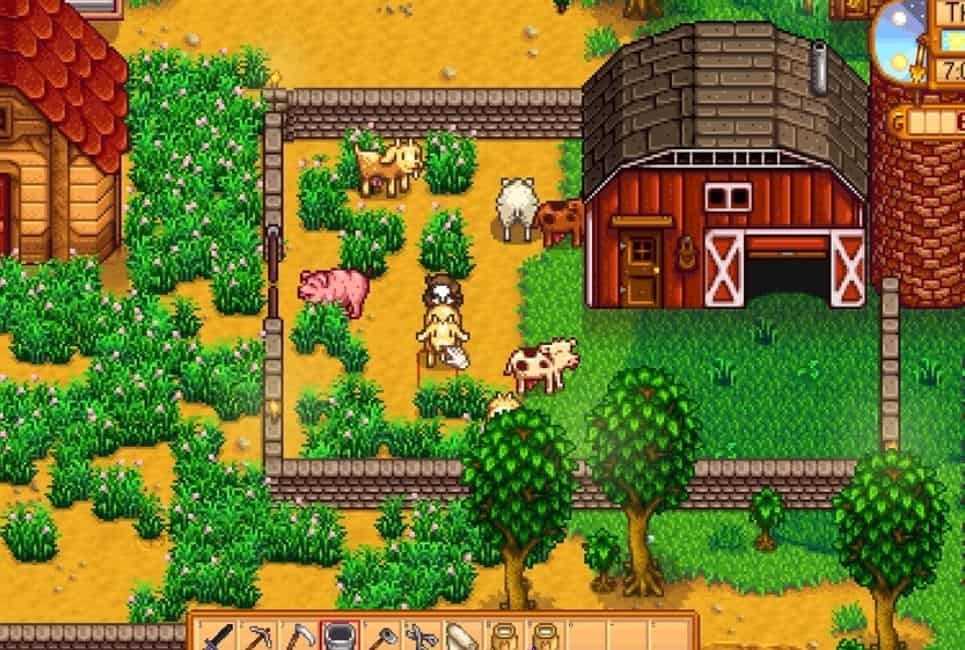- Stardew Valley Roleplay Ideas – A New Way to Farm - May 9, 2023
- Stardew Valley Multiplayer Guide: Farm With Friends - February 27, 2023
- Stardew Valley Feast of the Winter Star Guide: A Winter Wonderland - January 23, 2023
, in a nutshell, could be described as a very simple game with a lot of moving parts. You can play this game casually and just go with the flow, or you could be like me and genuinely consider breaking out spreadsheets to optimize your time in .
That’s the beauty of this game; it gives you the freedom to approach it however you like. If you want to be a farmer that focuses solely on crops, you can do that. If you want to go through an entire playthrough and never spend any money at all, you can also do that. If you want to become a master adventurer and make it your goal to slay all the monsters in the land, you can do that.
Or, if you want to fill your with an abundance of cute little critters, you are invited to do so, provided Marnie is actually tending her shop. Today, we are focusing on the latter.
This game has two structures that are required to house and raise animals on your . The first of these structures that players will often purchase is the Coop. If you want to know more about this aspect of raising livestock, you should check out my Coop Guide.
However, after you build a Coop, the chances are that you will build yourself a . This is a larger building that is used to house the larger animals on offer in this game, such as , Goats, , and more. It’s a essential and one that you should add to your as soon as you can.
However, you may be wondering why this is considered so essential, what features it offers, how to acquire this building and what offer animals this building can home. Well, we aim to provide all this info and more, allowing you to create the ultimate layout that suits your tastes. So without further delay, here is our comprehensive .
What is a in ?
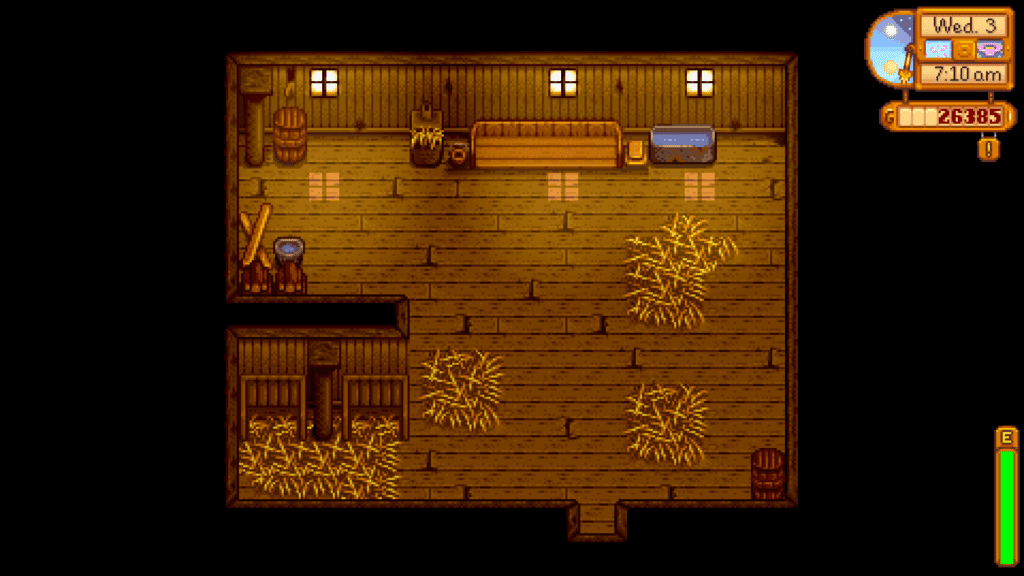
A in is a that serves as a home to the larger variety of animals the game has to offer. Much like a coop, the can build, place and then add animals to their structure and this can hold either four, eight, or twelve animals depending on which type of you have access to. Here is a rundown of each on offer and how they differ from one another:
Standard
- Cost: 6,000G
- Requirements: 350 Wood, 150 Stone
- Capacity: Four
- Features: , Hay Dispenser
Large
- Cost: 12,000G
- Requirements: 450 Wood, 200 Stone
- Capacity: Eight
- Features: Can Breed Animals
- Cost: 25,000G
- Requirements: 550 Wood, 300 Stone
- Capacity: Twelve
- Features: Auto Feeder
What Animals Can You Add to Your ?
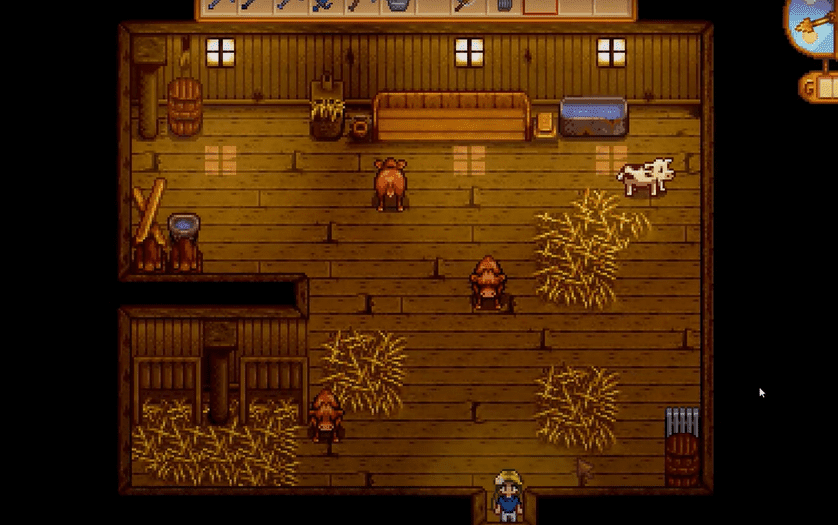
The first question that any lover playing this game will ask is, what animals can I put in my ? Well, this depends on what quality of you have at your disposal, but the good news is that regardless of whether you have a Standard or five Deluxe Barns on your property, you’ll still be able to load up on some cute creatures for your . Here is a rundown of each the game has to offer:
Cow
Cost: 1,500G
Requirements: Standard
Produces: ,
Let’s begin with , arguably the cutest of all the . As my wife says, ‘they are just big dogs,’ but I digress. These animals are key to your progression for a number of reasons. They produce and , which are needed to complete bundles within the Community Center.
You can only obtain this with the use of a , purchased in . They allow you to produce Cheese which can be a great money maker, especially if matured in the Cellar. Plus, these are inevitably the first you will purchase, so they serve as a means of teaching you how to care for all future Barnyard arrivals. are vital in and mark the beginning of your barnyard journey.
Cost: 4,000G
Requirements: Large
Produces: ‘s ,
Goats are the that mark the step up to the higher quality Barns in the game. These are the only new animals that players gain access to when they build a Large , but this shouldn’t discourage you as they too are vitally important. Goats produce Goats and that is needed for a Community Center bundle, and they also allow the to make Goats Cheese which is a more profitable dairy product than Cheese made with Cow’s . You can only obtain with the use of a , much like with the cow. Overall, a necessary stepping stone on the way to more luxury animals.

Cost: 8,000G
Requirements:
Produces:
Now we move onto , an that quite frankly feels a little unnecessary, especially when players gain access to via the . This is the quickest way to gain access to , which in turn is the quickest way to gain access to cloth.
These items allow the to complete bundles, create garments with the Sewing Machine, and can also help turn a tidy profit. However, when you take into account that a Rabbit produces and also has the chance of producing a rare item called a Foot, you soon realize that keeping just isn’t that worthwhile. However, we suggest you get one or two in the early game at least.
Pig
Cost: 16,000
Requirements:
Produces:
The Pig represents the pinnacle of Barnyard animals, in our opinion. A Pig in , when let outside to wander, will tread along the ground and gradually dig up rare truffles. These are luxury items and fetch quite a handsome price on their own.
However, when you place these in an Oil Maker, you can create Oil, another luxury item that can be sold for up to 1,491G. So, as you might have gathered, it literally pays to have a drove of on your .
Ostrich
Cost: N/A
Requirements: Acess to Ginger Island, Standard
Produces:
Then lastly, we have the Ostrich, a very unconventional farmyard but one that can be very profitable indeed. Technically, players can add this to their layout as soon as they buy their first Standard . However, the caveat of this is that players can only acquire an from Ginger Island and will also need an to allow for Breeding/incubation.
These animals, when fully grown, begin producing Ostrich Eggs of their own, and these can be incubated to produce more or sold for up to 1,440G each. This may be an that proves elusive for most of the game, but when you get one, you’ll soon see how beneficial they can be.
How to Get a in
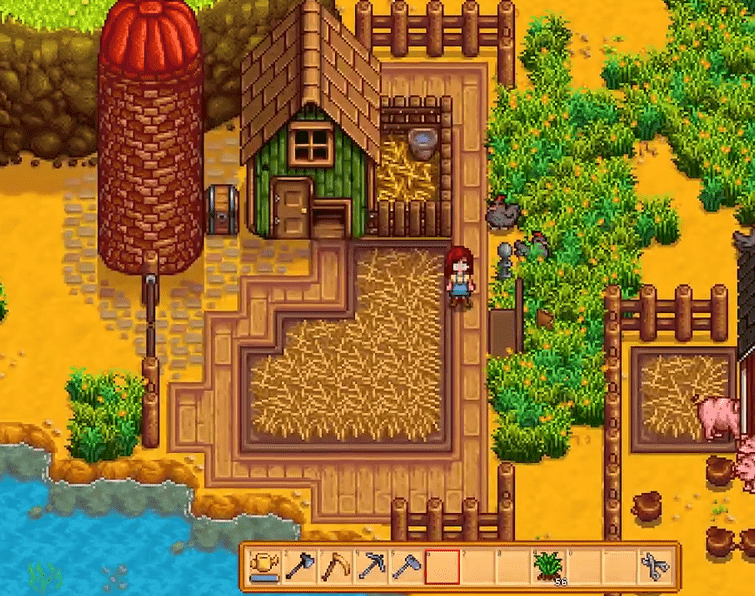
So now that you know what the has to offer and what cute animals you can add to your , you’ll want to know how you build a . Well, we wouldn’t leave you in the dark on that one. So here is a quick rundown on how to build your first below:
Step one: Gather Resources
Firstly, you will have to gather the necessary resources to build the , but thankfully you won’t have to acquire anything that isn’t available in abundance. All you need is a healthy supply of both stone and wood. To get wood, you’ll need to set aside a good portion of the day to chop trees and gather up to 350 pieces.
Trees usually give out about seventeen to twenty pieces of wood, so you’ll need to cut down at least 18-20 trees. Then as for stone, the best way to accumulate these is to hit the mines and mine rocks. The best rocks to mine are the large boulders that give ten stones per boulder.
Step Two: Clear Space
After you have all the necessary materials, you’ll need to make sure you have space on your to place a . As you tend to purchase your first rather early in the game, the chances are that you will have a that is still largely covered in debris.
If you don’t clear this and head up to Robin’s shop to place a building, the game will not allow you to build on top of the debris. So find a spot on the that you like and mark a clear space out for your . This will save a lot of unnecessary back and forth.
Step Three: Buy Your
Then lastly, all you have to do now is go and buy your . Along with your gathered resources, you’ll need 6,000G for your first , so make sure you save up before you go trying to build.
Once you have the funds, walk up to Robin’s in the Mountains just north of center and interact with her when she is tending the shop. There will be an option where it reads ‘Construct .’ Select this and then select the option, place it as you desire on your , and then after two days of construction, you will be the proud owner of your own .
How to Care for
We won’t dwell on this too long as this doesn’t really differ from to , whether they live in a Coop or a , but equally, we want to give you all the necessary tools to succeed. So here are some best practices to tend to your :
Feeding
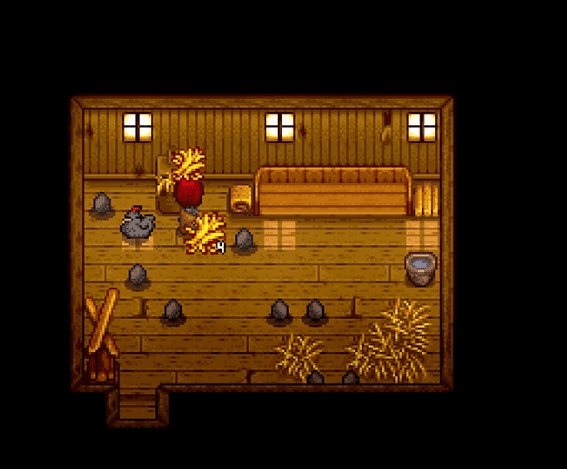
To keep your animals happy and producing regularly, you need to make sure that each is fed daily. So you need to make sure that you have a good supply of Hay on the at all times. This can be accomplished by building silos and cutting long , allowing animals to seek out their own food in the tall , or you can buy Hay from south of the . However, we would suggest building two silos before you even consider taking on animals.
Petting
If you want your produce to be the best of the best, you need to bond with your animals. A higher friendship meter means better . To raise your with your animals, you need to interact with them daily, petting them and showing affection. If you do this, your animals will grow to love you and regularly produce high-quality items.
Indoor/Outdoor Time
Then lastly, It’s important to let your animals graze from time to time. This can bring down on your feeding costs if you utilize Starters well, and it makes the animals happier as a collective, so it is well worth doing.
Then on the flip side, in Winter, you need to ensure that you keep your animals inside and provide heaters to keep them happy and healthy in the Winter season. Also, don’t ever leave your animals outside overnight. This will make them very upset, and not only that, but they will also be susceptible to attacks and could die.
Benefits of a in
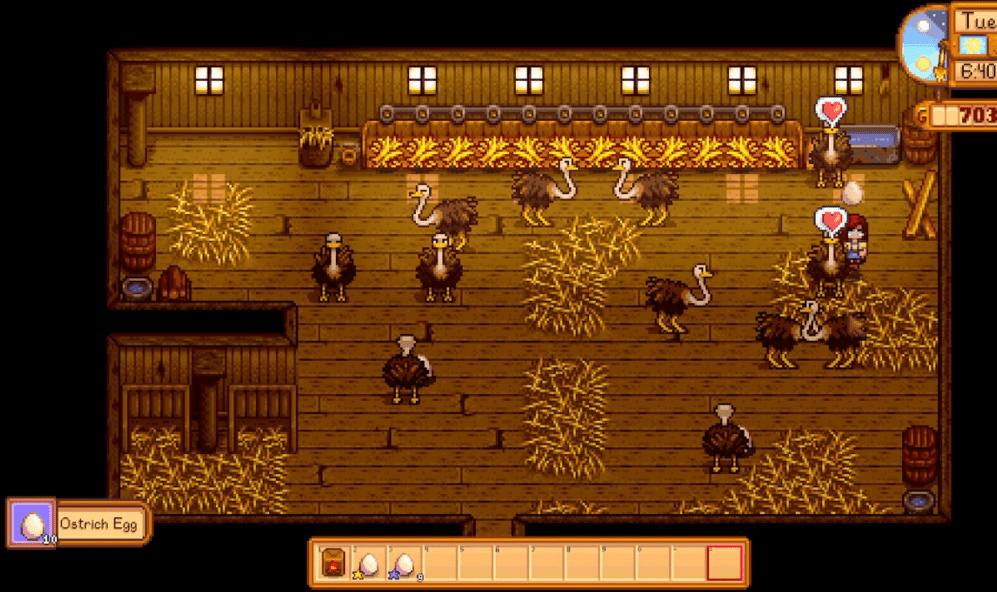
So, you now understand how to keep animals happy and how to get your up and running in the first place. However, if you are still not sold on why a is a essential, well, this section is handmade for you. Here is a rundown of all the key benefits that Barns provide in :
Profit
Let’s deal with the most obvious reason to get a , the sweet, sweet cash. Depending on what animals the decides to go with, there is the potential to make a good amount of money relative to the point in the game you are playing through.
You can sell the raw products for a quick buck, you can make artisan goods for an extra bump in pay, or you can mature items like Cheese and make even more cash. Then when you start farming Truffles and Ostrich Eggs, you’ll begin to see your wallet bursting. Overall, Barns are a great money-making venture.
Bundles
The other main benefit of investing in a is that you can get your hands on some important items which are essential for completing the Community Center. You will need , , and to complete the bundle.
You will also need a for the Chef’s Bundle, and you will need Cheese, Cheese, Cloth, and Oil for the Artisan Bundle. So as you can see, having a can be a brilliant way to speed up your overall progress within .
Gifts
While this wouldn’t be number one on my list of reasons why you should get a , I would suggest that you make use of some of the products as they do make great gifts if given to the right people. For example, Leah loves Truffles, Harvey loves Oil, Emily loves Cloth, Robin loves Goats Cheese. Honestly, the list goes on, and it’s all about experimenting and finding who loves what and then showering them with gifts regularly.
Companionship
Then lastly, a perhaps overlooked aspect of getting on the . Having these animals gives you an inherent sense of responsibility and companionship.
I can’t tell you how long I have spent blankly staring at a screen thinking of the perfect name for a new addition to the family, and that is simply because the game makes you care about these little pixellated animals.
Other Helpful Tips
Now just before we sign off, we want to leave you with a few additional tips that make all the difference when it comes to getting a and tending to your Barnyard Animals. Here are some quick tips below:
Invest In a Silo First
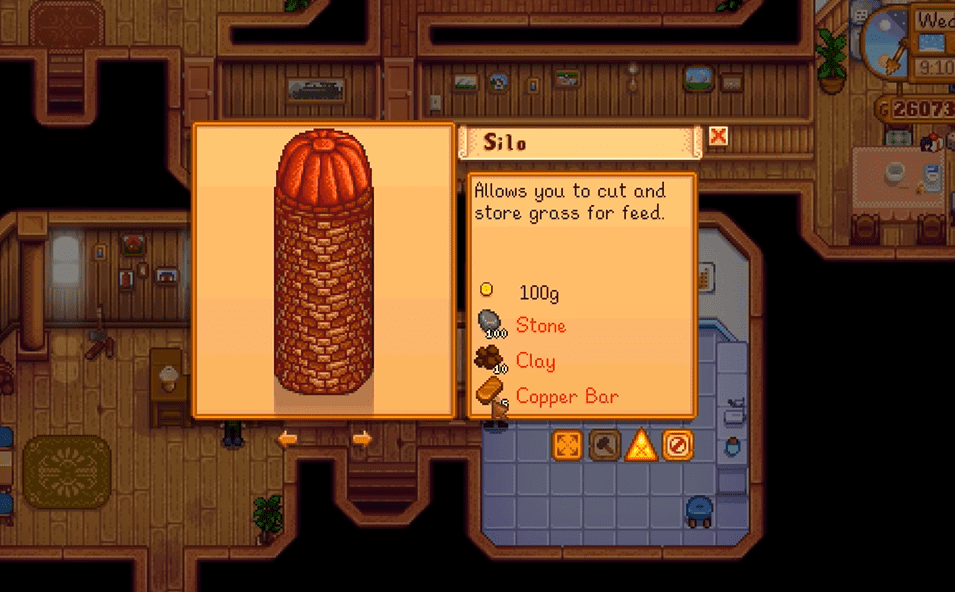
One thing we would suggest before you even consider buying a is building a Silo or two. These are other that allow you to store Hay up to 250 pieces. You can use your scythe to cut long on your , and you will have a 50% chance (or 75% chance with the Golden Scythe) to add some hay to your Silo with each chop.
Hay can be expensive, especially early in the game, so using the resources you already have at your disposal is vital. So to summarise, Silo then , in that order.
Craft Lots of Machines
To get the most out of your raw materials and make the most cash, you’ll want to turn them into Artisan Goods, and to do that, you’ll need Artisan Equipment or Machines.
These are craftable items like Cheese Presses or Mayonaisee machines, for example, which boost the profits of your natural produce. We would suggest that you have one machine for every applicable you own if possible. Here is a quick list of all the machines you’ll want to craft to cater to all animals in a :
- Mayonaise Machine (Ostrich)
- Cheese Press (Cow and )
- Loom ()
- Oil Maker (Pig)
Invest In Auto Grabbers and Petters
Then lastly, if you have gotten quite some way through the game and your is fairly profitable, it might be time to splash the cash and invest in some luxury items. Auto Grabbers and Auto Petters are just that.
These are machines that, when placed in a Coop or , gather the animals produce or pet each , respectively. This is a real-time saver and allows you to automate your , freeing up your time for other things like early trips to the Skull Cavern in the Calico Desert, for example.
FAQs
Question: What is the Best Barn Animal?
Answer: This will be subjective depending on the preference and playstyle of the player in question. However, answering from my own point of view, I would have to say that Pigs are hard to overlook here. Pigs are able to dig up Truffles which in turn produce Truffle Oil which is a super money maker and a great gift if you know who to gift this to. It’s a big investment at 16,000G, but you will make this back in a number of weeks, and then after that, it’s all profit, baby!
Question: What is the Best Animal Farm Layout?
Answer: The various layouts in Stardew Valley offer different things that will suit varying playstyles, so a good thing to consider is which one will suit a farmer that mainly relies on profits through animal products. Well, we would suggest that you simply go with a Standard Layout in this case.
This is because with Coops and Barns, you want to place as many as you can on the farm and the standard layout offers the most open space of all options provided. Obviously, you can still add barns to all layouts, but if you want the maximum amount of cute animals, you’ll want the standard layout.
Question: Can I Sell My Farm Animals?
Answer: Yes, you can, but truthfully we don’t see why you would. You can technically make a profit from selling these animals, but the profits are so minuscule. To the point that just keeping the animals and collecting their products for about two days would outweigh this profit from selling. The only reason you should sell your animals is if you need to make room for new animals, but even then, it’s a great excuse to build more Barns.
Stardew Valley Barn Guide: Final Thoughts
As you can see from the information above, a Barn in Stardew Valley is a very worthwhile investment. The player can get their hands on some cool animals, some luxury produces, and even make some premium artisan goods if they have the right tools to do so.
Alongside a coop, the player can collect all the possible animals and enjoy all the benefits that this brings. We urge you to invest in a Barn early and reap the rewards. We hope that this guide serves you well, and as always, thank you for reading SdewHQ.

